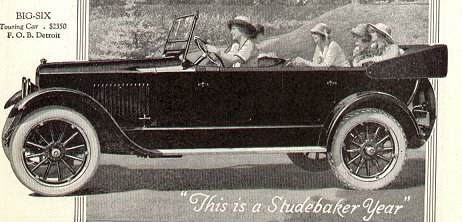Studebaker
|
|
Lazystude1.jpg
| Contents |
Early history
Henry Studebaker was a farmer, blacksmith, and wagon-maker who lived near Gettysburg, Pennsylvania in the early 19th century. By 1840 he had moved to Ohio and taught his five sons to make wagons. They all went into that business as they grew westward with the country.
Studewheellogo.jpg
When the gold rush settled down, John returned to Indiana and bought out Henry's share of the business. They brought in their youngest brother Jacob and incorporated in 1852. Expansion continued to support westward migration, but the next major increase came from supplying wagons for the Union Army in the American Civil War. After the war they reviewed what they had accomplished and set a direction for the company.
They reorganized into the Studebaker Brother's Manufacturing Company in 1868, built around the motto of "Always give more than you promise". By this time the railroad and steamship companies had become the big freight movers in the east. So they set their sights on supplying individuals and farmers the ability to move themselves and their goods. Peter's business became a branch operation.
During the height of westward migration and wagon train pioneering, half of the wagons were Studebakers. They made about a quarter of them, and manufactured the metal fittings to sell to other builders in Missouri for another quarter.
Studebaker Automobiles 1897-1966
Studebaker experimented with motor vehicles as early as 1897, choosing electric over gasoline powered engines. The company entered into a distribution agreement with Everett-Metzger-Flanders (EMF) Company of Detroit; EMF would manufacture vehicles and the Studebakers would distribute them through their wagon dealers. Problems with EMF made the cars unreliable leading the public to say that EMF stood for "Every Morning Fix-it". J.M. Studebaker, unhappy with EMF's poor quality, gained control of the assets and plant facilities in 1910. To remedy the damage done by EMF, Studebaker paid mechanics to visit each unsatisfied owner and replace the defective parts in their vehicles at a cost of $1,000,000 to the company. Studebaker also began putting its name on new automobiles produced at the former EMF facilities, both as an assurance that the vehicles were well built, and as its commitment to making automobile production and sales a success. In in 1911 the company reorganized as the Studebaker Corporation.Studebakerwoods1.jpg
From the 1920s to the 1960s, the South Bend company originated many style and engineering milestones, including the classic 1929-1932 Studebaker President and the 1939 Studebaker Champion. Studebaker continued to build models that appealed the average American and their need for transportation and mobility.
However, ballooning labor costs (the company had never had an official United Auto Workers (UAW) strike and Studebaker workers and retirees were among the highest paid in the industry), quality control issues and the new car war between Ford and General Motors in the early 1950s wrecked havoc on Studebaker's balance sheet. Professional financial managers stressed short term earnings rather than long term vision. There was enough momentum to keep going for another ten years, but stiff competition and price cutting by the Big Three doomed the enterprise.
Turningwheelsstudie2.jpg
Hoping to stem the tide of losses and bolster its market position, Studebaker allowed itself to be acquired by Packard Motor Car Company of Detroit; the merged entity was called the Studebaker-Packard Corporation through 1962. Studebaker's cash position was far worse then it led Packard to believe and in 1958 the nearly bankrupt automaker brought in a management team from aircraft maker Curtis-Wright to help get it back on its feet. In 1958, Packard was discontinued; the company became the American agent for Mercedes-Benz and many Studebaker dealers sold that brand as well.
Many of Studebaker's dealers converted to Mercedes Benz dealerships following the closure of the Canadian plant. Studebaker's proving grounds were acquired by its former supplier Bendix Corporation, which later donated the grounds for use as a park to the St. Joseph County, Indiana parks department. As a condition of the donation, the new park was named park Bendix Woods.
1963studebaker.jpg
77_1_b.jpg
After 1966, Studebaker continued to exist as a closed investment group, with income derived from its numerous diversified units including STP, Gravely Tractor, Onan Electric Generators and Clarke Floor Machine. Studebaker was acquired by Wagner Electric in 1967. Subsequently, Studebaker was then merged with the Worthington Corporation to form Studebaker-Worthington before being acquired by McGraw-Edison in 1979. McGraw-Edison was itself acquired in 1985 by Cooper Industries, which sold off all its auto-parts divisions to Federal-Mogul some years later.
As reported by Forbes magazine in 2004 in an article on companies which survived the 1929 stock market crash, the remains of the automaker still exist as Studebaker-Worthington Leasing, a subsidiary of State Bank of Long Island (amex: STB). The current owner of the Studebaker trademark is low-volume manufacturer Avanti Motor Corporation, in Villa Rica, Georgia.
See also
Studebaker models
- Studebaker President (1927-42) (1955-58)
- Studebaker Dictator (1927-36)
- Studebaker Land Cruiser (1947-54)
- Studebaker Wagonaire (1963-66)
- Studebaker Champion (1939-58)
- Studebaker Scotsman (1957-58)
- Studebaker Commander (1927-35) (1937-58) (1964-66)
- Studebaker Conestoga (1954-55)
- Studebaker Speedster (1955)
- Hawk series:
- Studebaker Golden Hawk (1956-58)
- Studebaker Silver Hawk (1957-59)
- Studebaker Sky Hawk (1956)
- Studebaker Flight Hawk (1956)
- Studebaker Power Hawk (1956)
- Studebaker Hawk (1960-61)
- Studebaker Gran Turismo Hawk (1962-64)
- Studebaker Lark (1959-1966) (Includes Cruiser, Daytona and Lark based Commander)
- Studebaker Avanti (1963-64)
Studebaker Body Styles
- Studebaker Starlight (1947-55, 1958)
External links
- The Studebaker Museum (http://www.studebakermuseum.org/museum.htm)
- The Studebaker Drivers Club (http://www.studebakerdriversclub.com)
- Studebaker-Worthington Leasing (http://www.studebaker.com) - a corporate descendant of the historical car company
- Studebaker Motor Company (http://www.studebakermotorcompany.com) - an unrelated modern company, but has some pages on Studebaker historyde:Studebaker


